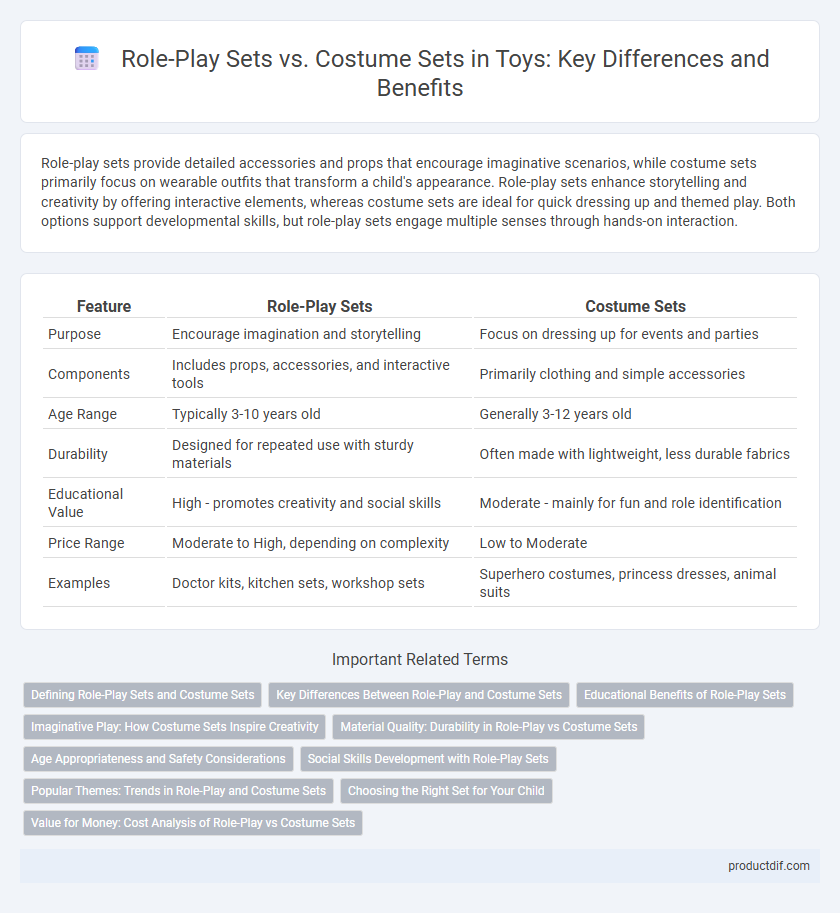Role-play sets provide detailed accessories and props that encourage imaginative scenarios, while costume sets primarily focus on wearable outfits that transform a child's appearance. Role-play sets enhance storytelling and creativity by offering interactive elements, whereas costume sets are ideal for quick dressing up and themed play. Both options support developmental skills, but role-play sets engage multiple senses through hands-on interaction.
Table of Comparison
| Feature | Role-Play Sets | Costume Sets |
|---|---|---|
| Purpose | Encourage imagination and storytelling | Focus on dressing up for events and parties |
| Components | Includes props, accessories, and interactive tools | Primarily clothing and simple accessories |
| Age Range | Typically 3-10 years old | Generally 3-12 years old |
| Durability | Designed for repeated use with sturdy materials | Often made with lightweight, less durable fabrics |
| Educational Value | High - promotes creativity and social skills | Moderate - mainly for fun and role identification |
| Price Range | Moderate to High, depending on complexity | Low to Moderate |
| Examples | Doctor kits, kitchen sets, workshop sets | Superhero costumes, princess dresses, animal suits |
Defining Role-Play Sets and Costume Sets
Role-play sets are designed to enhance imaginative play by providing children with themed accessories and props that encourage storytelling and character interaction, such as doctor kits or kitchen sets. Costume sets primarily consist of wearable outfits and accessories that allow children to transform into specific characters or professions, emphasizing visual and tactile dress-up experiences. Both sets foster creativity, but role-play sets focus on interactive scenarios while costume sets prioritize physical transformation and appearance.
Key Differences Between Role-Play and Costume Sets
Role-play sets provide children with accessories and props designed to encourage imaginative scenarios and interactive storytelling, while costume sets primarily focus on wearable outfits that transform the child's appearance. Role-play sets often include items like kitchen tools, doctor kits, or tool benches, promoting hands-on engagement, whereas costume sets feature themed clothing such as superhero suits or princess dresses aimed at visual transformation. The key difference lies in role-play sets fostering active participation and creativity, whereas costume sets emphasize dress-up and character portrayal.
Educational Benefits of Role-Play Sets
Role-play sets provide children with immersive learning experiences that stimulate creativity, social skills, and problem-solving abilities. These sets often include realistic props and scenarios that encourage cognitive development and empathy by allowing kids to explore various roles and professions. Unlike costume sets, role-play sets promote interactive storytelling and collaboration, enhancing both language and emotional intelligence through hands-on exploration.
Imaginative Play: How Costume Sets Inspire Creativity
Costume sets encourage imaginative play by allowing children to embody different characters and scenarios, fostering creativity and emotional development. Unlike role-play sets that often provide specific props and settings, costume sets offer open-ended opportunities for storytelling and self-expression. This versatility enhances cognitive skills as children invent narratives and explore diverse roles through dress-up.
Material Quality: Durability in Role-Play vs Costume Sets
Role-play sets typically feature higher-quality materials such as heavy-duty fabrics and reinforced stitching, ensuring durability during extended play. Costume sets often use lighter, less durable materials like thin polyester or nylon, designed primarily for short-term wear. This material difference impacts the longevity and usability of the toys, making role-play sets a better investment for long-term imaginative play.
Age Appropriateness and Safety Considerations
Role-play sets are designed with age-appropriate themes and components, ensuring safe, non-toxic materials suitable for young children's developmental stages. Costume sets may include small parts or accessories that pose choking hazards for toddlers, making them better suited for older children who understand proper use. Prioritizing safety certifications like ASTM F963 and CPSIA compliance helps caregivers select both role-play and costume sets that match a child's age and minimize injury risks.
Social Skills Development with Role-Play Sets
Role-play sets foster social skills development by encouraging cooperative play, communication, and empathy through shared storytelling and character interaction. Costume sets primarily support imaginative expression but often lack the structured scenarios that promote collaborative problem-solving. Engaging with role-play sets enhances children's ability to negotiate, understand perspectives, and build interpersonal relationships in a social context.
Popular Themes: Trends in Role-Play and Costume Sets
Role-play sets and costume sets differ in design, with role-play sets focusing on interactive accessories that enhance imaginative play, while costume sets emphasize wearable outfits often linked to specific characters. Popular themes in these sets include superheroes, fantasy characters, and professions like doctors or firefighters, reflecting current media trends and children's interests. Recent market data shows a surge in demand for STEM-inspired role-play kits, combining education with imaginative storytelling.
Choosing the Right Set for Your Child
Role-play sets encourage creativity and social skills by providing themed accessories and props that stimulate imaginative scenarios, ideal for children who enjoy storytelling and interactive play. Costume sets, focusing on wearable outfits, enhance role immersion and self-expression, perfect for kids who love dressing up and acting out specific characters. Selecting the right set depends on your child's interests and developmental needs, balancing hands-on engagement with the desire for visual transformation.
Value for Money: Cost Analysis of Role-Play vs Costume Sets
Role-play sets generally offer greater value for money compared to costume sets due to their multifunctional components and durable quality, enabling extended play and creativity beyond simple dress-up. Costume sets often prioritize appearance and may lack versatility or longevity, potentially requiring frequent replacements that increase overall costs. Investing in role-play sets yields cost efficiency by combining dress-up elements with interactive accessories that enhance imaginative play.
Role-play sets vs costume sets Infographic

 productdif.com
productdif.com